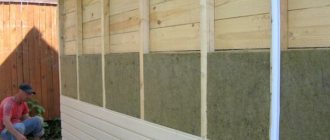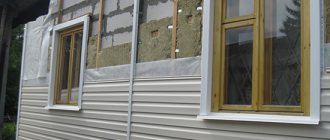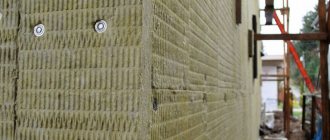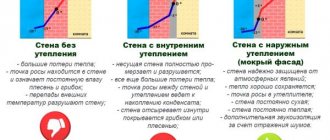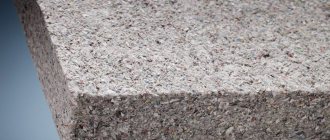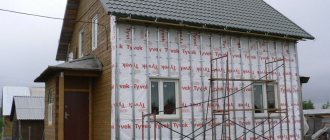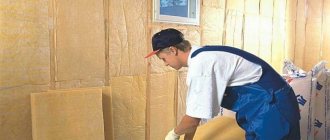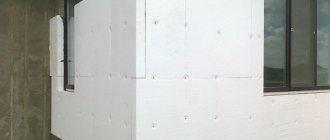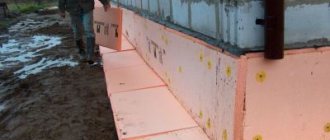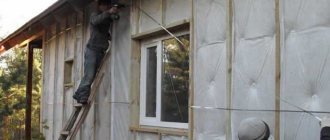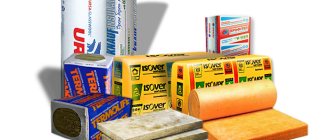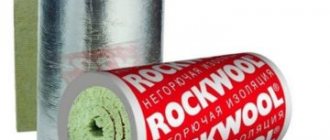Saving increased prices for energy resources is a pressing issue. Home owners are trying to insulate their buildings and reduce space heating costs. Exterior finishing with a ventilated siding facade not only gives the building a more attractive, stylish look, but also reduces heat loss. After all, thermal insulation is perfectly placed in the gap between the wall and the facing material. It is important to correctly select and install insulation for the walls of the house outside under the siding in order to reliably eliminate cold bridges in brick and large-block buildings at minimal cost. When choosing thermal insulation, several materials are worthy of attention: polystyrene foam, mineral wool, ecowool. But only after considering the technical characteristics of all heat-insulating materials can you make the right choice.
Is insulation needed for siding?
For specialists, this question is not difficult, since the answer is obvious. No house built of brick or blocks meets heat transfer resistance standards. This suggests that it is necessary to additionally insulate such houses.
The same can be said about houses made of wood. Of course, wood is an excellent heat-trapping material.
The standard thickness of the material used to build houses is enough to get a warm and comfortable home. But at the same time, insulating external walls will significantly reduce heating costs - gas, coal or firewood.
Finishing the facade of the building and the basement with siding allows you to create a ventilated facade. Insulation is excellent for it, so it would be imprudent to refuse to implement this option.
Therefore, experts advise deciding not whether insulation is required at all, but rather the correct choice of thermal insulation material.
Criterias of choice
The main selection criteria are price and free time. If the construction budget allows, then ecowool would be the best choice. This is especially true for wooden houses, since the seamless method allows you to close the smallest cracks.
On the other hand, you can insulate the building yourself with basalt wool, the difference will be insignificant, and you will save a good amount. Therefore, in matters of insulation, two factors are always important: money and free time.
It is imperative to pay attention to vapor permeability. The seller can easily describe this property as both negative and positive. Moreover, in any of the judgments he will be right. However, vapor permeability is necessary and it is better to choose materials that can “breathe”.
Requirements for insulation
A few words need to be said about the requirements for this material.
It must have the following properties:
- Durability;
- Aging resistance;
- Non-flammability;
- Biological resistance;
- Keep in shape;
- Easy and tight to install;
- Have excellent thermal insulation properties;
- Moisture and vapor permeability;
- Wind resistance.
These properties are characteristic of most modern thermal insulation materials. Currently, insulation materials such as mineral wool, ecowool, and polystyrene foam are used to create a ventilated facade under siding.
How thick should the insulation be laid?
To determine the thickness of the insulation, you should be guided by the following factors:
- How the house is planned to be used (permanent or seasonal);
- Climate of the area;
- Thermal conductivity characteristics of the selected material.
Calculation for houses with seasonal residence is not required. You can use any material, or do without insulation at all, if the temperature in the house is comfortable for living. For houses with permanent residence, brick, timber, foam block, aerated concrete, frame, log, insulation is required.
The choice depends on the material of the external walls:
- Reinforced concrete walls with a thickness of 230 millimeters require insulation up to 150 millimeters thick.
- Walls made of silicate, clay, ceramic and hollow bricks - insulation thickness - 100 millimeters.
- Walls made of coniferous timber 150 millimeters thick are insulated with at least 100 millimeters thick, and for timber 200 millimeters thick, material 50 millimeters thick is sufficient.
Facade cladding with your own hands
You can cover your house with siding yourself. First you need to calculate the amount of thermal insulation required. Having measured the area of the walls, you need to select the thickness of the heat-saving field. To reduce heat loss, a layer 8-10 mm thick is required, however, if funds allow, the thickness of the insulation can be increased to 15 mm.
After installing the insulation, it is necessary to install a protective layer. Siding sheathing will protect the thermal insulation layer from meteorological factors and extend the service life of the insulation. Installing insulation under metal siding or vinyl sheathing is very popular.
Chemical components of the material and microscopic dust can cause an allergic reaction or respiratory disease. After work, be sure to take a warm shower and change clothes!
Insulation for siding: advantages and disadvantages
Each type of material has its own positive characteristics and disadvantages. It is worth familiarizing yourself with the main types of thermal insulation materials and their properties in order to make the right choice.
Styrofoam
This material, like penoplex, is installed very quickly. But it cannot be said that polystyrene foam is the best method of insulation.
Its positive characteristics are as follows:
- Rigidity;
- Little weight;
- It is firmly attached to the wall surface, leaving no gaps. Dowels and glue can be used for this.
This is where the advantages end. Apart from the loyal price of polystyrene foam, and its cost is approximately the same as mineral wool, we can highlight the following disadvantages of the material:
- Polystyrene foam is a polymer , and their service life is relatively short. Only about 15 years, then it simply loses its properties and collapses.
- Low level of vapor permeability. Natural air exchange does not occur, which leads to increased humidity. As a result, the house requires the installation of a high-quality ventilation system. And this leads to the loss of precious heat.
- There are various rumors about the soundproofing properties of polystyrene foam . Most likely, the indicators of good sound insulation are just an advertising gimmick. Since the material tightly fixed to the wall can even increase the sound. It hits the resonant frequency of sound vibrations, such as human speech.
Minvata
Mineral wool is excellent for insulating walls made of any materials. In addition, it perfectly matches the design of the house with siding, both plastic and metal. You just have to consider what kind of cotton wool you should purchase.
It is better to choose the sheet version, since it will be difficult to attach rolled cotton wool. Moreover, the soft rolled mineral wool will subsequently slide down, leaving sections of the wall without insulation.
When fixed, mineral wool should be insulated using a vapor barrier film. This is necessary in order to protect the siding from small components of wool and create unhindered penetration of steam from the wall of the house into the ventilation gaps.
Mineral wool has excellent heat and sound insulation properties. Since its structure is loose, this allows you to hide various sounds that come from the street. The cost of mineral wool is on average slightly higher than that of polystyrene foam.
Ecowool
This material has almost the same properties as mineral wool. At the same time, it has a number of its own characteristics.
These include:
- Environmental friendliness;
- It is not subject to rotting and burning, due to the fact that safe borax and boric acid are added to it;
- The adhesion to the surface is tight, this is ensured by a special technology that is used to attach the wool to the wall;
- Over time, it does not shrink;
- The price of the material is low compared to the above materials.
Currently available only in rolls. The cost of applying it to the wall is very high, this is due to the fact that the fastening is quite difficult.
Glass wool
It is considered the cheapest thermal insulation material on the market.
The advantages include:
- Moisture and fire resistance;
- Does not emit harmful substances or fumes;
- Excellent thermal and sound insulation properties.
But glass wool also has a number of disadvantages:
- Glass particles released into the air can penetrate the human body;
- This is a favorite environment for neighbors such as mice.
Extruded polystyrene foam (EPS)
Produced synthetically since the middle of the last century. It is actively used for insulating walls not only in residential buildings, but also for insulating roofs and creating warm floors. It consists of microgranules that are similar to foam.
But it has distinctive features:
- Low thermal conductivity;
- Minimum water absorption;
- Light weight.
Extruded polystyrene foam compares favorably with conventional polystyrene foam. But it also has its drawbacks.
These include:
- Flammability;
- Combustion toxicity;
- Poor vapor permeability. The house requires a good ventilation system.
The service life of this material is quite high, it reaches 40 years.
Features of the material
Mineral wool is suitable for insulating walls lined with metal or plastic siding. As a facade insulation for siding, it is better to use mineral wool not in rolls, but in semi-rigid slabs, which are easier to install. To avoid the formation of dust from mineral wool, it is recommended to use a vapor barrier film.
This type of facade insulation, installed under siding, is characterized by high sound and heat insulating properties.
Thanks to its loose fibrous structure, the material absorbs different types of noise well: airborne, impact and structural. These are environmentally friendly products. Mineral wool is easy to give the required shape, and during operation it is characterized by durability.
For the optimal choice of insulation for walls under siding based on price, technical and operational characteristics, call our qualified specialists.
They will advise you on installation technology, recommend a material with certain parameters, depending on the operating conditions and the requirements for thermal insulation. We will answer questions regarding the application features and subtleties of installing mineral wool. To clarify the terms of purchase, contact our managers.
Preparing the wall surface
Preparing the wall surface with your own hands for attaching insulation to it is as follows:
- All protruding objects are removed from the wall.
- The surface is leveled. To do this, it should be taken into account that the depth of the depressions and protrusions should not be more than 20 millimeters.
- If required, the wall surface should be treated with a primer and leveled with a plaster solution. The primer should be chosen for external use.
Then the insulation is prepared.
Laying insulation under siding
The work is carried out in the following order:
A vertical sheathing is created. The sheathing pitch is 30 centimeters. To create it, wooden blocks can be used, which are fixed to the surface with dowels. Installation is carried out smoothly; a building level is used for this. This is necessary so that the siding can be properly secured and a smooth surface can be obtained.- The selected insulation is placed in the gaps between the sheathing. Its installation depends on the type of material. The insulation is attached directly to the wall of the house; no intermediate materials should be installed between it and the wall.
- A vapor barrier material is applied to the insulation layer . It allows you to remove moisture from the walls of the house, while preventing its penetration from the outside. It can be secured using staples.
At this stage, you should create a ventilation gap with a height of 20 millimeters. To do this, you will need a block with a cross-sectional area of 40*20 millimeters. It is installed at the same pitch as the sheathing.
Next, you can begin installing the siding.
How to connect the backlight yourself
Making and connecting kitchen lighting is easy. LED strips under cabinets are especially popular today. All you need to do is secure it with adhesive tape or fasteners, and then connect it to the network.
Note! As for other lighting sources, they can be connected according to a diagram taken from the Internet. Carrying out work with rubber gloves as a guarantee of safety when connecting lighting equipment
Carrying out work with rubber gloves as a guarantee of safety when connecting lighting equipment
In general, there is only one condition for lighting - it must comply with regulatory rules
At the same time, attention should be paid to a fluorescent lamp or LED backlight due to their economical use. As for the switch, you can install either a surface-mounted switch or a dimmer
You can connect any lighting yourself using simple recommendations.
Tips for installing insulation
- Thermal insulation material can be attached to the wall in several ways: using dowels, glue, mastic. The choice of fastening method depends on the type of material.
- The simplest installation method is to create a heat-insulating layer, attach the sheathing to it, then install the siding.
- The insulation is always placed between the bars from which the frame is created. Its thickness should be at least 2.5 centimeters greater than the thickness of the sheathing.
- The insulation is laid vertically between the bars of the horizontal frame. And the siding is mounted on a horizontal frame, which is created on top of the insulation.
- The most reliable way to attach insulation is using glue or mushroom spacers. But this is also the most expensive option. It allows you to additionally protect the walls from blowing.
Installation of siding panels
Siding installation begins with the creation of a second horizontal sheathing. It is fastened in order to create a ventilated façade. Siding sheets are attached to this sheathing.
There are two types of siding:
- Vinyl.
- Metal.
Vinyl siding This is a budget option, one piece costs from 100 rubles. This material lasts a long time with proper care, but it is very easy to damage. Metal siding Its cost is from 350 rubles per piece, but metal siding lasts much longer. In order to install siding more competently, you should take into account the main mistakes that are made.
Siding installation errors
The following mistakes are usually made when covering a facade with siding:
- Fastening with nails until it stops.
- The connection of elements is too tight . These errors lead to the material being deformed and a so-called “wave” appearing on the surface. Vinyl siding can shrink and expand at different temperatures, so it is necessary to make small gaps, up to 1.5 millimeters in size.
- There are no gaps left between the ends of solid siding panels and additional elements. This leads to the fact that when the material expands along its length, there will be no expansion gap left. A distance of up to 10 millimeters should be left.
- It is not recommended to drive nails directly into the siding. It should be installed in the perforated holes of the panel exactly in the center so that deformation does not damage the siding. Sooner or later this can happen under the influence of different temperatures. And if the fastening is done correctly, the panel will be able to move freely.
- Do not neglect additional elements. They were not invented in vain; their use allows you to secure the siding correctly and efficiently. These elements allow you to hide slopes, near-window areas, and corner joints.
- It should be understood that high-quality siding cannot be cheap.
"Eryap Plastic"
Most of the products with polyurethane foam coating are supplied from Turkey. Since 2001, it has been providing the domestic market with high-quality building materials in the mid-price category.
In addition to siding, the company can purchase high-quality and reliable insulation for panels for cladding a wooden or brick house.
Advantages of American Siding siding
The “American Siding” series combines the best qualities of a facing material for finishing the exterior of a brick or wooden building. The siding is quite durable, is not susceptible to cracking in severe frosts and retains its original color.
All panels are multi-colored and have a smooth transition. Even if you take a close look at the facade, you might think that it was not vinyl siding that was used to decorate the outside of the house, but natural stone or valuable wood.
Brick siding
Siding panels are the most convenient to install. They are easy to use, fastening occurs by snapping or connecting with self-tapping screws.
Brick siding has a number of attractive features:
- Easy to care for. It can be simply washed with plain water, without abrasives.
- Long service life;
- Impact resistance and ductility;
- Attractive appearance;
- Withstands temperatures ranging from 50 degrees below zero to 60 degrees above zero;
- Resistant to sun exposure.
Brick siding allows you to create a traditional, strict home design. And the highlight of the building will be given by color, the choice of which is currently huge. The dimensions of the panels are small, this allows you to decorate not only the entire surface of the wall, but also individual places. This material can also be used to create various fences.
Advantages of cone drills
Stepped products have the following positive properties:
- allow you to make a hole with smoother edges compared to spiral and feather counterparts;
- For holes of different diameters, one step drill is used;
- perfectly centers the hole;
- used for processing very thin sheet metal;
- ideal for processing non-ferrous metals;
- for large volumes of work, it saves time due to the absence of the need to frequently replace drills of different diameters.
A step drill allows you not only to perform high-quality drilling of metals, but also to correct hole defects that were made with other types of products. For example, if the center of the hole is displaced when using spiral analogues, a conical one can completely correct the defect.
It is also possible to expand the holes if necessary to a fixed diameter. Despite the higher cost of cone drills, significant savings can be achieved with frequent use. Due to the absence of the need to purchase a large number of tools of different diameters.
